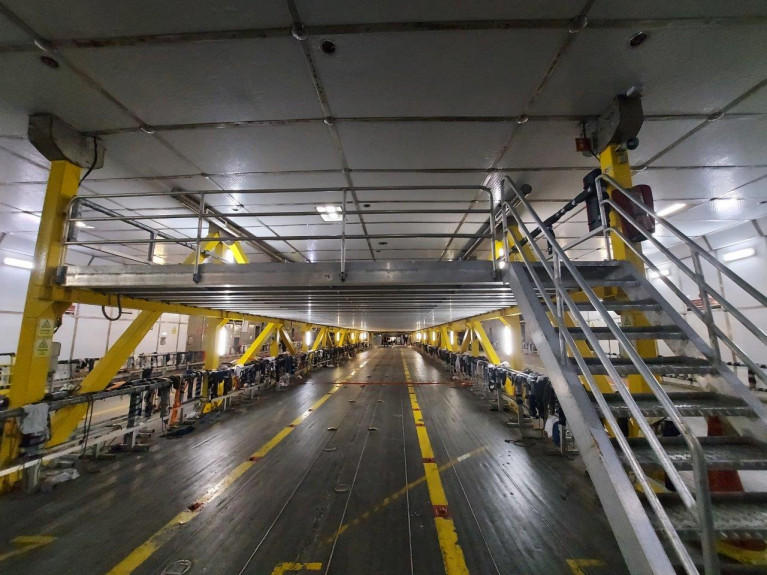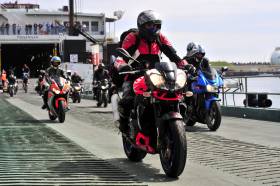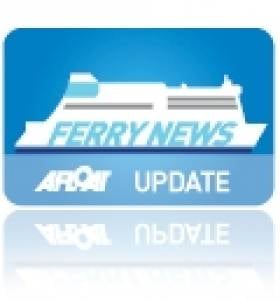Displaying items by tag: TT Races
Passenger ferry figures for those booked on the Isle of Man Steam Packet sailings for the annual TT are up this year.
This will be the first year for visitors traveling for the motorsport fortnight (May 27–June 8) when coming from Heysham to use the ferry company’s new flagship, Manxman.
Approximately 45% of passengers bound for the sporting event have opted to reach the Isle of Man when they depart from the Lancashire port that links Douglas.
The flagship, which entered service last August, can take 948 passengers; that’s over 300 more per sailing than the former flagship, the ropax Ben-my-Chree. Also, the new build built in Asia has 10% more vehicle lane capacity.
As for the 26-year-old ropax, it remains in the company's fleet as a backup vessel and is based in Douglas Harbour.
However, more capacity is available, according to Steam Packet’s Managing Director, Brian Thomson, who has more to say on the fortnight.
To listen, ManxRadio has an audio clip.
The Isle of Man Steam Packet Company has announced there will be changes to four sailings during this year’s TT Races to be held next month.
These particular ferry crossings, initially set to take place on the Douglas-Liverpool route between June 2 and June 3, have been moved to Heysham, the terminal in Lancashire, which serves the main route to the Manx capital.
The move of English port, reports IOMToday, comes after Global Ports Holding (GPH), the new operator at Pier Head in Liverpool, told the IOMSPCo that a previously agreed usage of the Landing Stage (see new terminal) on those days will prevent the ferry operators’ high-speed craft, Manannan from using the berth.
The Steam Packet’s M.D., Brian Thomson, said: ‘We have sought to reduce the inconvenience to our customers by securing as much use of the Pier Head landing stage as possible, especially during the busiest time of our year’.
Approximately 34,000 visitors have travelled to the Isle of Man by sea for the TT this year.
Rob Callister MHK, who has responsibility for the TT, said this figure was up by 3,000 people from 2019.
‘It’s normally only 31,000 on the ferry, so that’s gone up,’ he told the Isle of Man Examiner.
Overall, in 2019 there were 46,000 visitors to the island for the TT fortnight.’
He continued: ‘They’ve obviously taken capacity away from the airlines because airlines haven’t had as many extra flights as usual for the TT.’
The TT has returned with a number of new features, including the newly developed TT Plus app, which has been designed for people to watch the races live from their devices, with over 40 hours of live coverage across the event.
The Isle of Man Today has more on the influx of visitors that use the IOM Steam Packet Company routes.
#FerryNews - Passengers totalling 34,000 according to Isle of Man.com travelled by sea over the TT fortnight.
The Isle of Man Steam Packet Company says final figures for this year are 'on a par' with 2017.
13,236 motorbikes were also transported between May 23rd and June 8th.
The Ben-my-Chree and Manannan worked around the clock to transport passengers whilst MV Arrow covered freight services.
The Steam Packet says more than 11,000 passengers travelled from Heysham with over 12,500 travelling from Liverpool.
For more on this and bookings for 2019's TT Races click here.
Extra Freight Ferry Chartered for Manx TT Races
#MANX TT RACES FERRY NEWS – According to BBC News, an additional ro-ro freight-ferry has been chartered from Seatruck Ferries by the Isle of Man Steam Packet Company in order to cope with demand during the TT races.
More than 11,200 motorbikes are already booked to arrive in Douglas during race fortnight, which begins on Monday. The number is the highest for a decade with the exception of the event's centenary in 2007.
The chartered vessel is the Arrow (1998/7,606grt), which will assist in peak periods. The 122m long vessel can transport around 1,000 metres of freight and is the sister ship of Helliar, which covered during the island's passenger ferry Ben-my-Chree's scheduled dry dock.
Steam Packet Company Chief Executive Mark Woodward said: "While MV Arrow doesn't bring any additional passenger space, we have already made provision for 43,000 extra seats scheduled over the TT period."
"This second chartered vessel provides additional operational resilience during the busiest time of the year."































































